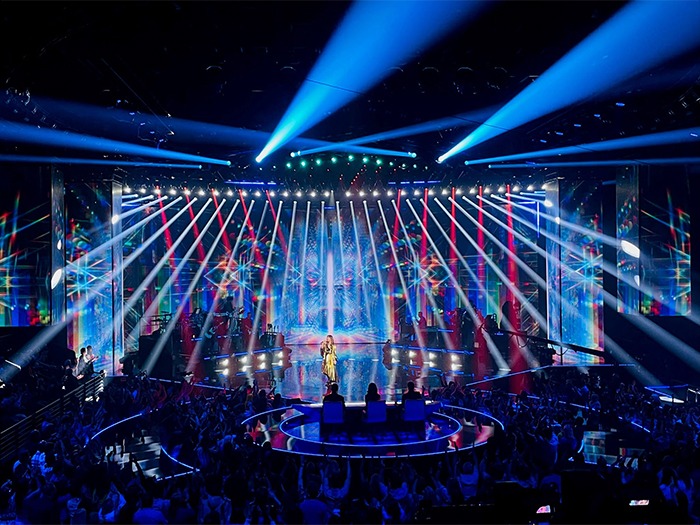The live finals of American Idol 2023 moved to a new venue – Red Studios Hollywood – giving lighting designer Tom Sutherland of DX7 design and production designer Florian Wieder the chance to create a fresh and exciting new look in this special space, which has embraced history and innovation in film and TV production since the early 20th century.
Sutherland included plenty of Robe moving lights on his lighting plot, including 137 x MegaPointes, now a near iconic luminaire about which he states, “I would not do a show without MegaPointes”. Robe’s original multi-tasking MegaPointe is an international favorite and has a unique status in the history of moving lights!
These were joined by 104 x Robe Tetra2 moving LED battens, another fixture that Sutherland loves for creating specific looks and effects. He also used 49 x Spiider LED wash beams, a highly practical luminaire with outstanding color mixing that he frequently specifies, together with BMFL Blade Follow Spots.
The new set was one starting point for his lighting design concept. Elegant and modern, the performance area was a distinctive diamond shape, and the overall set incorporated a host of LED sources; screens, paneling, and strip lighting, plus a striking LED floor. So, to look good against all this, Sutherland needed plenty of brightness.
Another parameter was the nature of the studios themselves. Originally opened in 1915 as Metro Pictures, while the stages have been modernized to house today’s productions, installing a large rock ‘n’ roll set and lighting rig required skillful crafting.
Sutherland decided to mirror the diamond floor design with a grid of Spiiders above in the roof, resembling a contemporary chandelier offering multiple cool and animated looks, some using the pixel control.
A frame of MegaPointes surrounded this grid, and more were positioned all along the stage surround truss at the front, above the side edges of the stage, and along ‘on-stage truss 1’ which curved around the back of the stage area.
They were augmented with five MegaPointes a side on the deck and four behind the live band to create nice structural looks and silhouette effects from that angle.
Sutherland is a MegaPointe fan for all the reasons that have made them one of the industry’s go-to FX lights, “You can simply do so much with them,” he noted, and over the course of a series like American Idol, where 26 live final competitors compete for the ‘Idol’ crown over 6 episodes shot in a 6-week timeframe it was all about creating dynamics and variety.
He reckons that around 200 unique lighting and video environments are created over the period – with hundreds more lighting cues within each of these – as the artists are whittled down to the final two!
The Tetra2s were utilized to frame the upstage LED screen, a large area that split apart and tracked left and right to allow entrances and exits. The idea was to evoke an arch effect of Tetra2s.
In addition to these Robe products, there were approximately 700 other lights on the rig. “The challenge is always to make sure you’re using the most appropriate tech and ensure you are always pushing the boundaries and keeping things looking unique and distinctive,” Sutherland commented.
This year’s edition was the third American Idol series which he has lit.
He really enjoyed working with Wieder – well known for his clean yet multi-faceted TV sets and production architecture – and the two of them work extremely closely, discussing how lighting and video can always complement and contrast one another, adding drama and depth to the visual equation.
Sutherland appreciates that Wieder totally understands lighting and how it needs to function, and his designs always reflect this, building lighting into the design from the outset. “We communicate really well, always look at the bigger picture together, and together with creative director Brian Burke, enjoy a great fluidity and understanding in our exchange of ideas and end-goals.”
Each of the hi-energy, fast-paced American Idol broadcasts lasts two hours, so that is a lot of attention spans to keep onside. The shows play to a live audience of 750, a combination of standing (in the pit) and seated that brings additional resonance, atmosphere and vibrance.
All the series lighting was programmed onto a grandMA3 console and operated by Bobby Gray and Harry Forster, who worked on the first and second halves of the season respectively. White lights were controlled by Nate Files, the series director was Phil Heyes and the executive producers were Matt Banks and Megan Wolflick.
Lighting equipment was supplied by Felix Lighting, with all things co-ordinated and managed by account handler, Nicole Barnes, another colleague with whom Sutherland enjoys working and has an excellent rapport.

